Analyzing Health Workforce Planning: Nursing in Australia
VerifiedAdded on 2023/06/14
|12
|2423
|367
Report
AI Summary
This report addresses the critical issue of decreasing nursing professionals in Australia, attributing it to factors such as burnout, aging workforce, and poor retention rates. It presents data on the number of nursing professionals across Australian states and territories, highlighting a concerning decrease in registered midwives and enrolled nurses despite an overall increase in registered nurses. The report analyzes the environmental scan of the Australian nursing workforce, referencing data from the Australian Institute of Health and Welfare (AIHW) and other studies to project future workforce shortages, particularly in aged care, mental healthcare, and midwifery. It further examines the geographical distribution of the nursing workforce and analyzes recommendations from the AIHW, focusing on building leadership capacity, improving retention through early career support, and incorporating innovations to enhance productivity. The report concludes by emphasizing the need for a comprehensive approach, including addressing remuneration-related aspects, to ensure the long-term sustainability of the nursing workforce in Australia. Desklib provides access to similar solved assignments and resources for students.
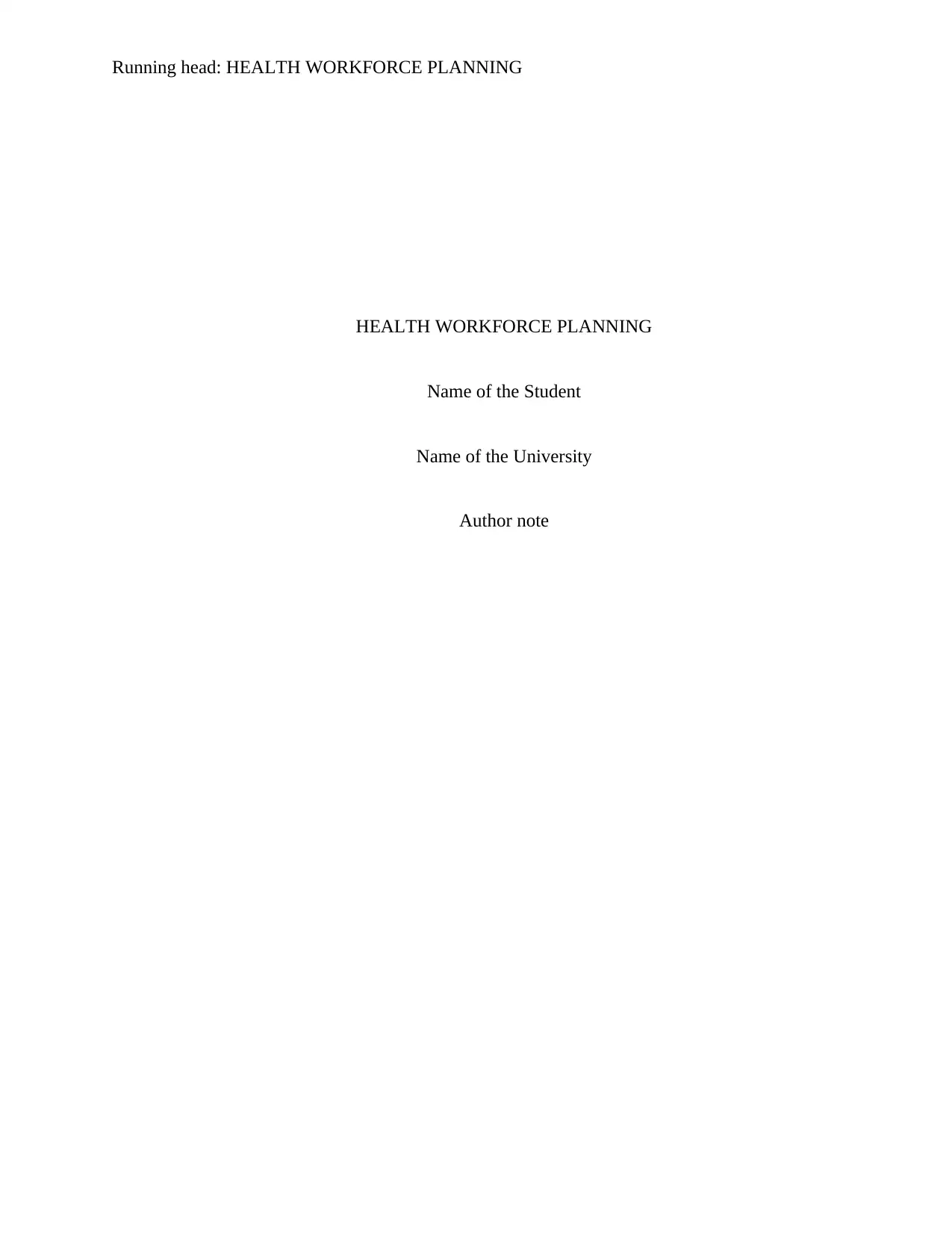
Running head: HEALTH WORKFORCE PLANNING
HEALTH WORKFORCE PLANNING
Name of the Student
Name of the University
Author note
HEALTH WORKFORCE PLANNING
Name of the Student
Name of the University
Author note
Paraphrase This Document
Need a fresh take? Get an instant paraphrase of this document with our AI Paraphraser
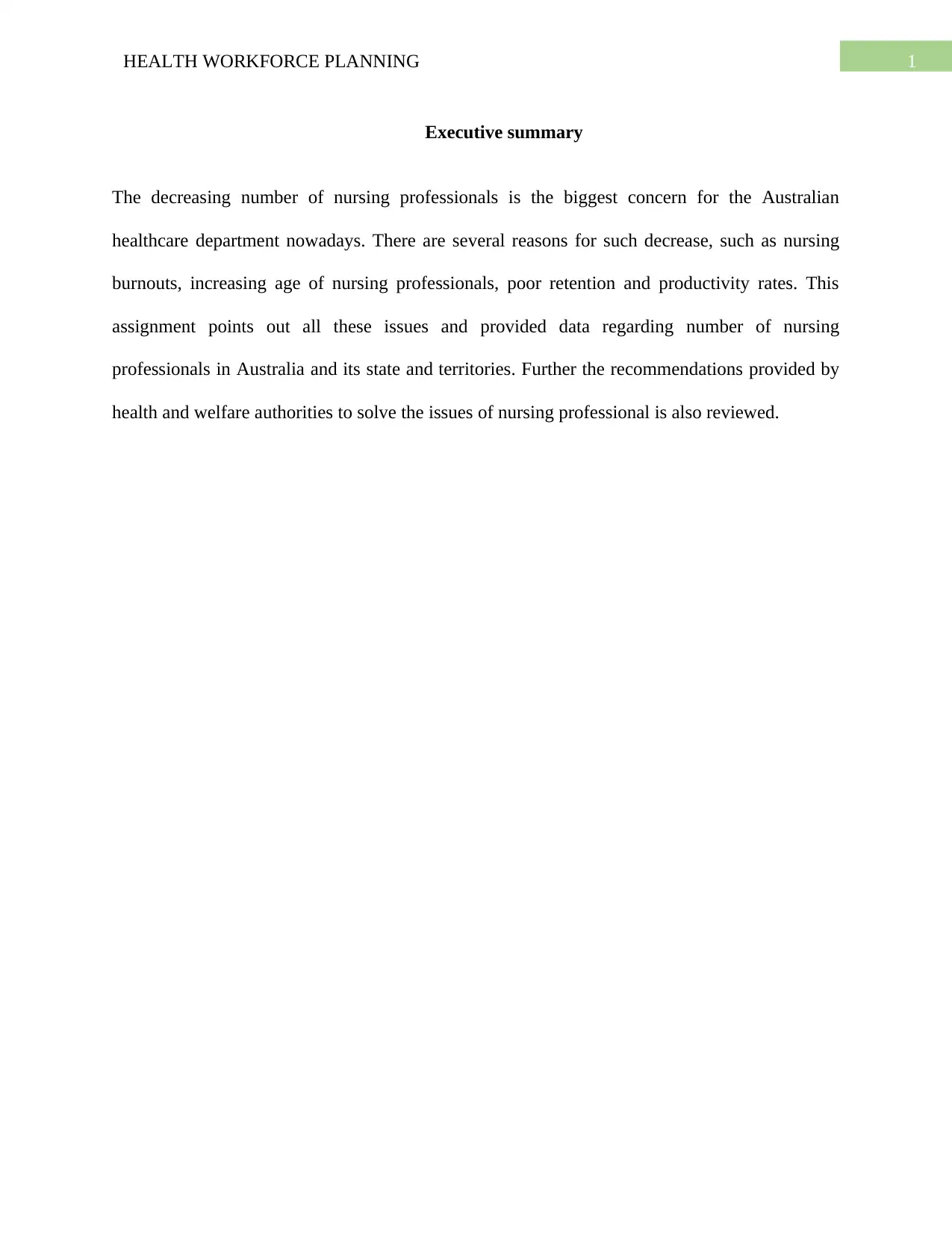
1HEALTH WORKFORCE PLANNING
Executive summary
The decreasing number of nursing professionals is the biggest concern for the Australian
healthcare department nowadays. There are several reasons for such decrease, such as nursing
burnouts, increasing age of nursing professionals, poor retention and productivity rates. This
assignment points out all these issues and provided data regarding number of nursing
professionals in Australia and its state and territories. Further the recommendations provided by
health and welfare authorities to solve the issues of nursing professional is also reviewed.
Executive summary
The decreasing number of nursing professionals is the biggest concern for the Australian
healthcare department nowadays. There are several reasons for such decrease, such as nursing
burnouts, increasing age of nursing professionals, poor retention and productivity rates. This
assignment points out all these issues and provided data regarding number of nursing
professionals in Australia and its state and territories. Further the recommendations provided by
health and welfare authorities to solve the issues of nursing professional is also reviewed.
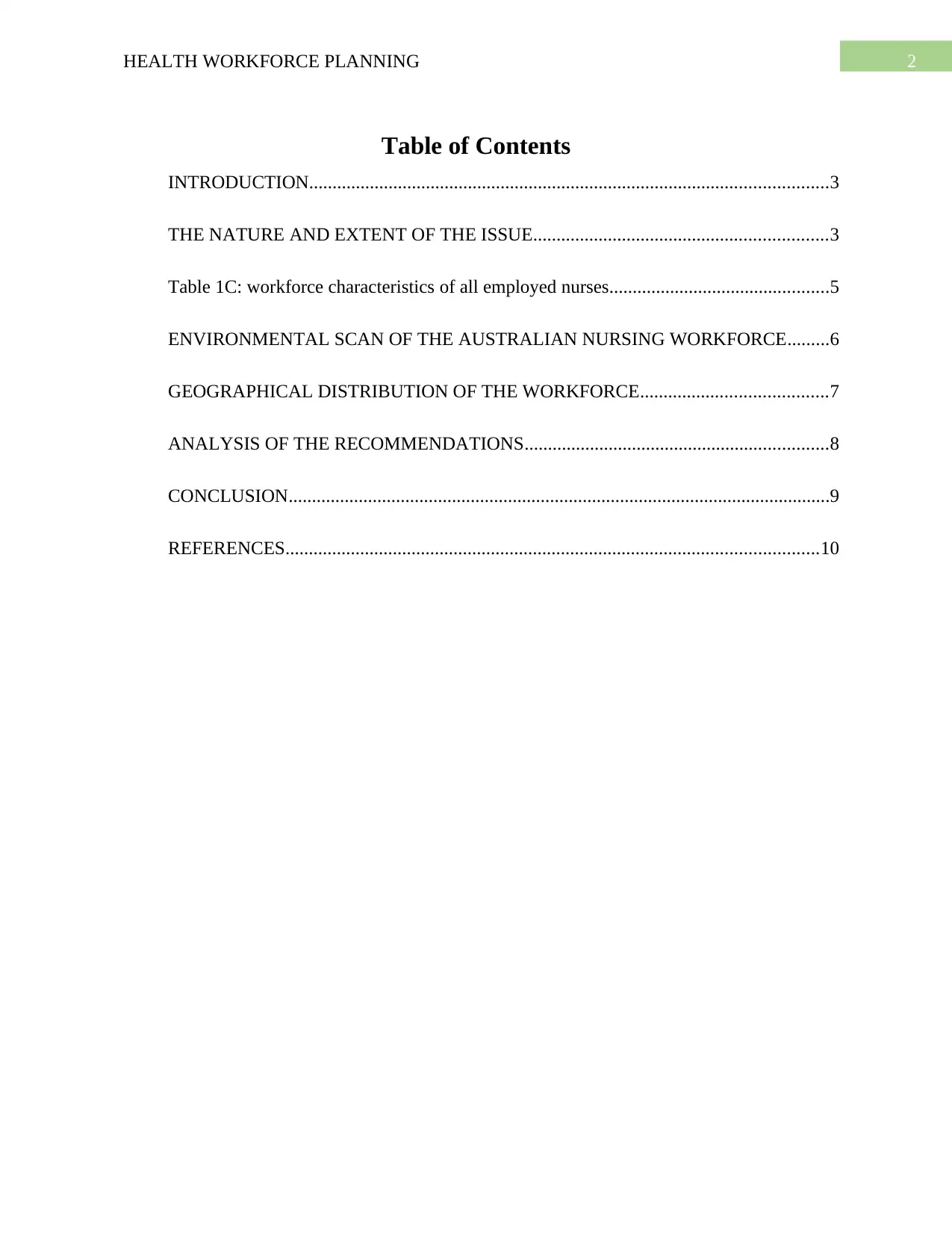
2HEALTH WORKFORCE PLANNING
Table of Contents
INTRODUCTION...............................................................................................................3
THE NATURE AND EXTENT OF THE ISSUE...............................................................3
Table 1C: workforce characteristics of all employed nurses...............................................5
ENVIRONMENTAL SCAN OF THE AUSTRALIAN NURSING WORKFORCE.........6
GEOGRAPHICAL DISTRIBUTION OF THE WORKFORCE........................................7
ANALYSIS OF THE RECOMMENDATIONS.................................................................8
CONCLUSION....................................................................................................................9
REFERENCES..................................................................................................................10
Table of Contents
INTRODUCTION...............................................................................................................3
THE NATURE AND EXTENT OF THE ISSUE...............................................................3
Table 1C: workforce characteristics of all employed nurses...............................................5
ENVIRONMENTAL SCAN OF THE AUSTRALIAN NURSING WORKFORCE.........6
GEOGRAPHICAL DISTRIBUTION OF THE WORKFORCE........................................7
ANALYSIS OF THE RECOMMENDATIONS.................................................................8
CONCLUSION....................................................................................................................9
REFERENCES..................................................................................................................10
⊘ This is a preview!⊘
Do you want full access?
Subscribe today to unlock all pages.

Trusted by 1+ million students worldwide
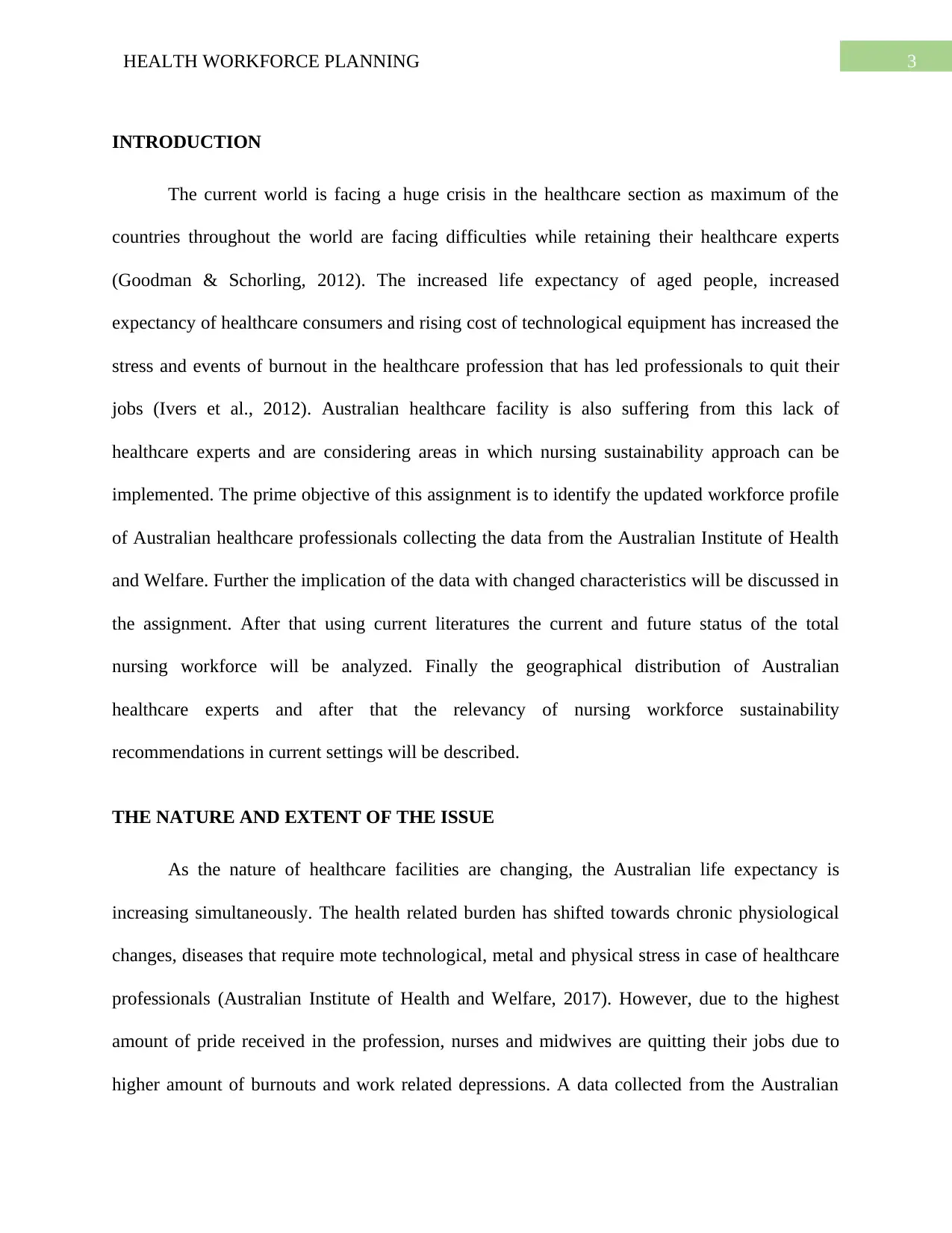
3HEALTH WORKFORCE PLANNING
INTRODUCTION
The current world is facing a huge crisis in the healthcare section as maximum of the
countries throughout the world are facing difficulties while retaining their healthcare experts
(Goodman & Schorling, 2012). The increased life expectancy of aged people, increased
expectancy of healthcare consumers and rising cost of technological equipment has increased the
stress and events of burnout in the healthcare profession that has led professionals to quit their
jobs (Ivers et al., 2012). Australian healthcare facility is also suffering from this lack of
healthcare experts and are considering areas in which nursing sustainability approach can be
implemented. The prime objective of this assignment is to identify the updated workforce profile
of Australian healthcare professionals collecting the data from the Australian Institute of Health
and Welfare. Further the implication of the data with changed characteristics will be discussed in
the assignment. After that using current literatures the current and future status of the total
nursing workforce will be analyzed. Finally the geographical distribution of Australian
healthcare experts and after that the relevancy of nursing workforce sustainability
recommendations in current settings will be described.
THE NATURE AND EXTENT OF THE ISSUE
As the nature of healthcare facilities are changing, the Australian life expectancy is
increasing simultaneously. The health related burden has shifted towards chronic physiological
changes, diseases that require mote technological, metal and physical stress in case of healthcare
professionals (Australian Institute of Health and Welfare, 2017). However, due to the highest
amount of pride received in the profession, nurses and midwives are quitting their jobs due to
higher amount of burnouts and work related depressions. A data collected from the Australian
INTRODUCTION
The current world is facing a huge crisis in the healthcare section as maximum of the
countries throughout the world are facing difficulties while retaining their healthcare experts
(Goodman & Schorling, 2012). The increased life expectancy of aged people, increased
expectancy of healthcare consumers and rising cost of technological equipment has increased the
stress and events of burnout in the healthcare profession that has led professionals to quit their
jobs (Ivers et al., 2012). Australian healthcare facility is also suffering from this lack of
healthcare experts and are considering areas in which nursing sustainability approach can be
implemented. The prime objective of this assignment is to identify the updated workforce profile
of Australian healthcare professionals collecting the data from the Australian Institute of Health
and Welfare. Further the implication of the data with changed characteristics will be discussed in
the assignment. After that using current literatures the current and future status of the total
nursing workforce will be analyzed. Finally the geographical distribution of Australian
healthcare experts and after that the relevancy of nursing workforce sustainability
recommendations in current settings will be described.
THE NATURE AND EXTENT OF THE ISSUE
As the nature of healthcare facilities are changing, the Australian life expectancy is
increasing simultaneously. The health related burden has shifted towards chronic physiological
changes, diseases that require mote technological, metal and physical stress in case of healthcare
professionals (Australian Institute of Health and Welfare, 2017). However, due to the highest
amount of pride received in the profession, nurses and midwives are quitting their jobs due to
higher amount of burnouts and work related depressions. A data collected from the Australian
Paraphrase This Document
Need a fresh take? Get an instant paraphrase of this document with our AI Paraphraser
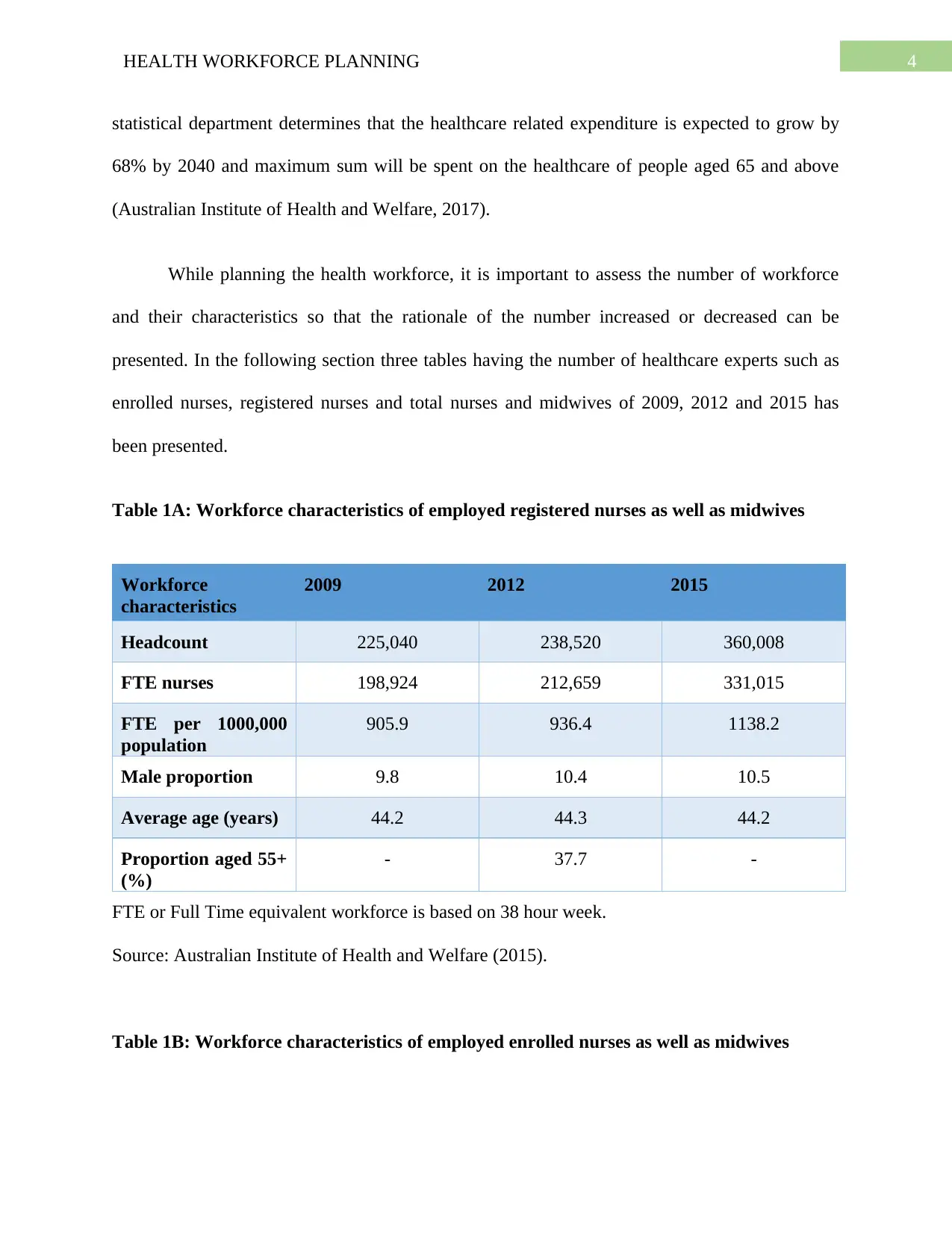
4HEALTH WORKFORCE PLANNING
statistical department determines that the healthcare related expenditure is expected to grow by
68% by 2040 and maximum sum will be spent on the healthcare of people aged 65 and above
(Australian Institute of Health and Welfare, 2017).
While planning the health workforce, it is important to assess the number of workforce
and their characteristics so that the rationale of the number increased or decreased can be
presented. In the following section three tables having the number of healthcare experts such as
enrolled nurses, registered nurses and total nurses and midwives of 2009, 2012 and 2015 has
been presented.
Table 1A: Workforce characteristics of employed registered nurses as well as midwives
Workforce
characteristics
2009 2012 2015
Headcount 225,040 238,520 360,008
FTE nurses 198,924 212,659 331,015
FTE per 1000,000
population
905.9 936.4 1138.2
Male proportion 9.8 10.4 10.5
Average age (years) 44.2 44.3 44.2
Proportion aged 55+
(%)
- 37.7 -
FTE or Full Time equivalent workforce is based on 38 hour week.
Source: Australian Institute of Health and Welfare (2015).
Table 1B: Workforce characteristics of employed enrolled nurses as well as midwives
statistical department determines that the healthcare related expenditure is expected to grow by
68% by 2040 and maximum sum will be spent on the healthcare of people aged 65 and above
(Australian Institute of Health and Welfare, 2017).
While planning the health workforce, it is important to assess the number of workforce
and their characteristics so that the rationale of the number increased or decreased can be
presented. In the following section three tables having the number of healthcare experts such as
enrolled nurses, registered nurses and total nurses and midwives of 2009, 2012 and 2015 has
been presented.
Table 1A: Workforce characteristics of employed registered nurses as well as midwives
Workforce
characteristics
2009 2012 2015
Headcount 225,040 238,520 360,008
FTE nurses 198,924 212,659 331,015
FTE per 1000,000
population
905.9 936.4 1138.2
Male proportion 9.8 10.4 10.5
Average age (years) 44.2 44.3 44.2
Proportion aged 55+
(%)
- 37.7 -
FTE or Full Time equivalent workforce is based on 38 hour week.
Source: Australian Institute of Health and Welfare (2015).
Table 1B: Workforce characteristics of employed enrolled nurses as well as midwives
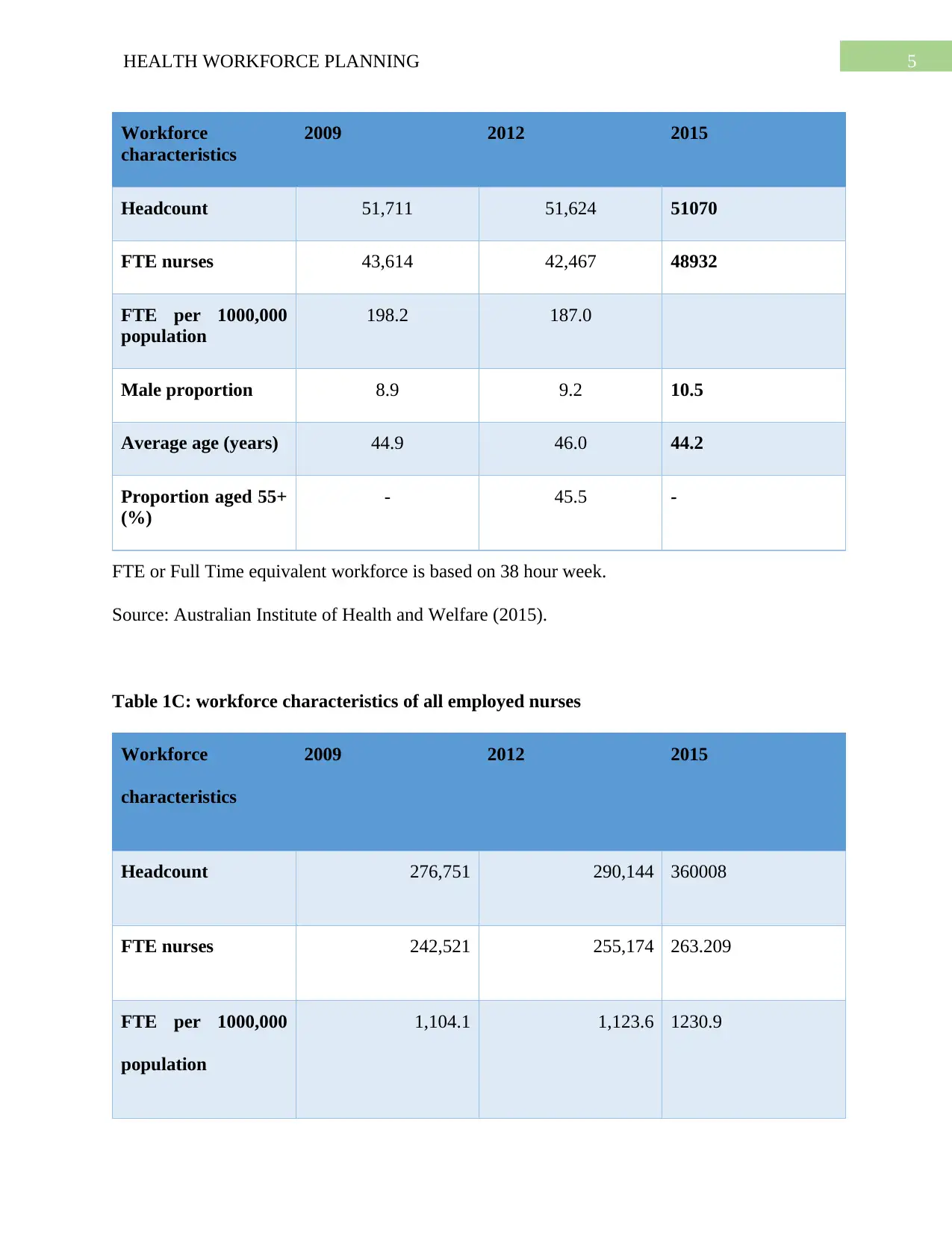
5HEALTH WORKFORCE PLANNING
Workforce
characteristics
2009 2012 2015
Headcount 51,711 51,624 51070
FTE nurses 43,614 42,467 48932
FTE per 1000,000
population
198.2 187.0
Male proportion 8.9 9.2 10.5
Average age (years) 44.9 46.0 44.2
Proportion aged 55+
(%)
- 45.5 -
FTE or Full Time equivalent workforce is based on 38 hour week.
Source: Australian Institute of Health and Welfare (2015).
Table 1C: workforce characteristics of all employed nurses
Workforce
characteristics
2009 2012 2015
Headcount 276,751 290,144 360008
FTE nurses 242,521 255,174 263.209
FTE per 1000,000
population
1,104.1 1,123.6 1230.9
Workforce
characteristics
2009 2012 2015
Headcount 51,711 51,624 51070
FTE nurses 43,614 42,467 48932
FTE per 1000,000
population
198.2 187.0
Male proportion 8.9 9.2 10.5
Average age (years) 44.9 46.0 44.2
Proportion aged 55+
(%)
- 45.5 -
FTE or Full Time equivalent workforce is based on 38 hour week.
Source: Australian Institute of Health and Welfare (2015).
Table 1C: workforce characteristics of all employed nurses
Workforce
characteristics
2009 2012 2015
Headcount 276,751 290,144 360008
FTE nurses 242,521 255,174 263.209
FTE per 1000,000
population
1,104.1 1,123.6 1230.9
⊘ This is a preview!⊘
Do you want full access?
Subscribe today to unlock all pages.

Trusted by 1+ million students worldwide
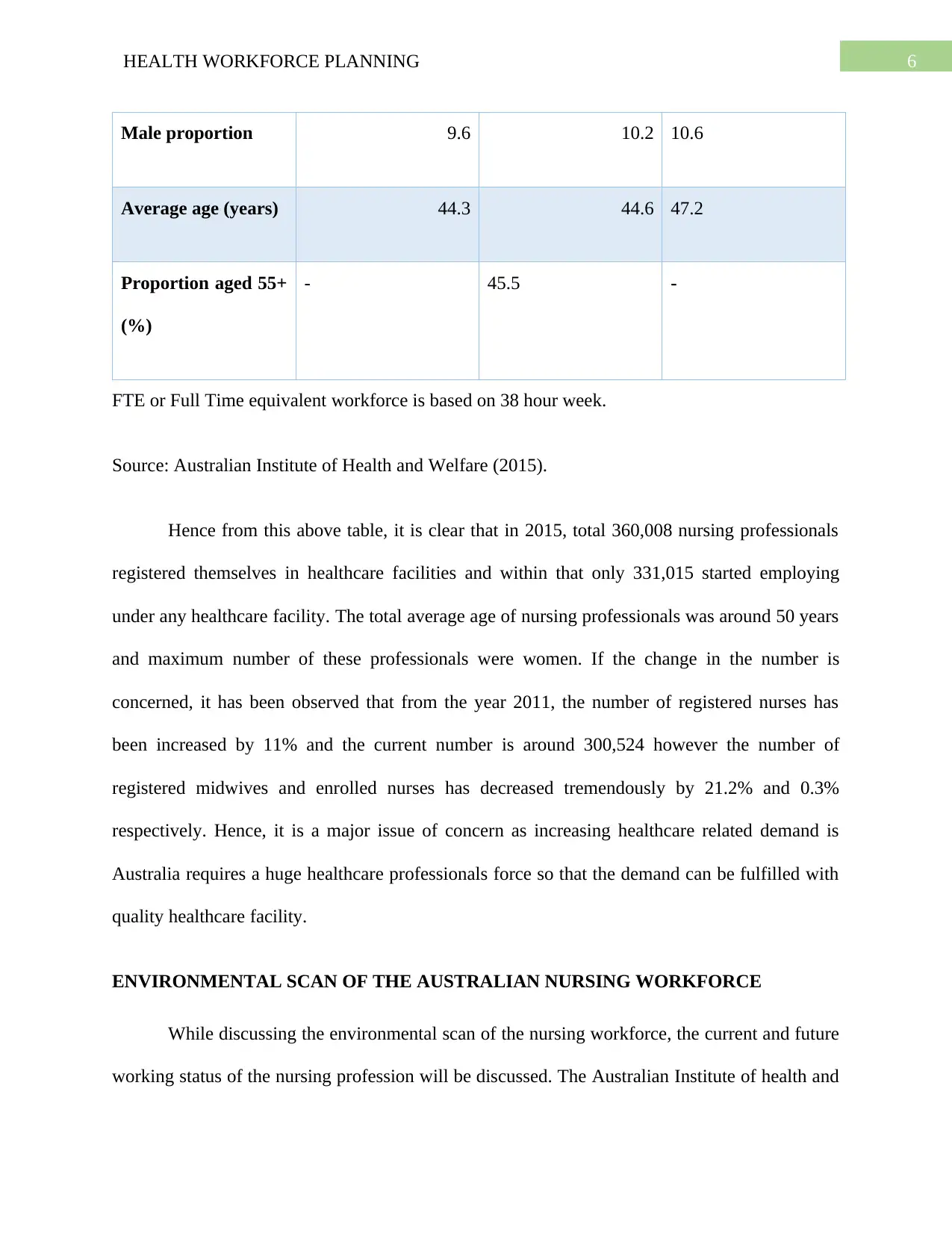
6HEALTH WORKFORCE PLANNING
Male proportion 9.6 10.2 10.6
Average age (years) 44.3 44.6 47.2
Proportion aged 55+
(%)
- 45.5 -
FTE or Full Time equivalent workforce is based on 38 hour week.
Source: Australian Institute of Health and Welfare (2015).
Hence from this above table, it is clear that in 2015, total 360,008 nursing professionals
registered themselves in healthcare facilities and within that only 331,015 started employing
under any healthcare facility. The total average age of nursing professionals was around 50 years
and maximum number of these professionals were women. If the change in the number is
concerned, it has been observed that from the year 2011, the number of registered nurses has
been increased by 11% and the current number is around 300,524 however the number of
registered midwives and enrolled nurses has decreased tremendously by 21.2% and 0.3%
respectively. Hence, it is a major issue of concern as increasing healthcare related demand is
Australia requires a huge healthcare professionals force so that the demand can be fulfilled with
quality healthcare facility.
ENVIRONMENTAL SCAN OF THE AUSTRALIAN NURSING WORKFORCE
While discussing the environmental scan of the nursing workforce, the current and future
working status of the nursing profession will be discussed. The Australian Institute of health and
Male proportion 9.6 10.2 10.6
Average age (years) 44.3 44.6 47.2
Proportion aged 55+
(%)
- 45.5 -
FTE or Full Time equivalent workforce is based on 38 hour week.
Source: Australian Institute of Health and Welfare (2015).
Hence from this above table, it is clear that in 2015, total 360,008 nursing professionals
registered themselves in healthcare facilities and within that only 331,015 started employing
under any healthcare facility. The total average age of nursing professionals was around 50 years
and maximum number of these professionals were women. If the change in the number is
concerned, it has been observed that from the year 2011, the number of registered nurses has
been increased by 11% and the current number is around 300,524 however the number of
registered midwives and enrolled nurses has decreased tremendously by 21.2% and 0.3%
respectively. Hence, it is a major issue of concern as increasing healthcare related demand is
Australia requires a huge healthcare professionals force so that the demand can be fulfilled with
quality healthcare facility.
ENVIRONMENTAL SCAN OF THE AUSTRALIAN NURSING WORKFORCE
While discussing the environmental scan of the nursing workforce, the current and future
working status of the nursing profession will be discussed. The Australian Institute of health and
Paraphrase This Document
Need a fresh take? Get an instant paraphrase of this document with our AI Paraphraser
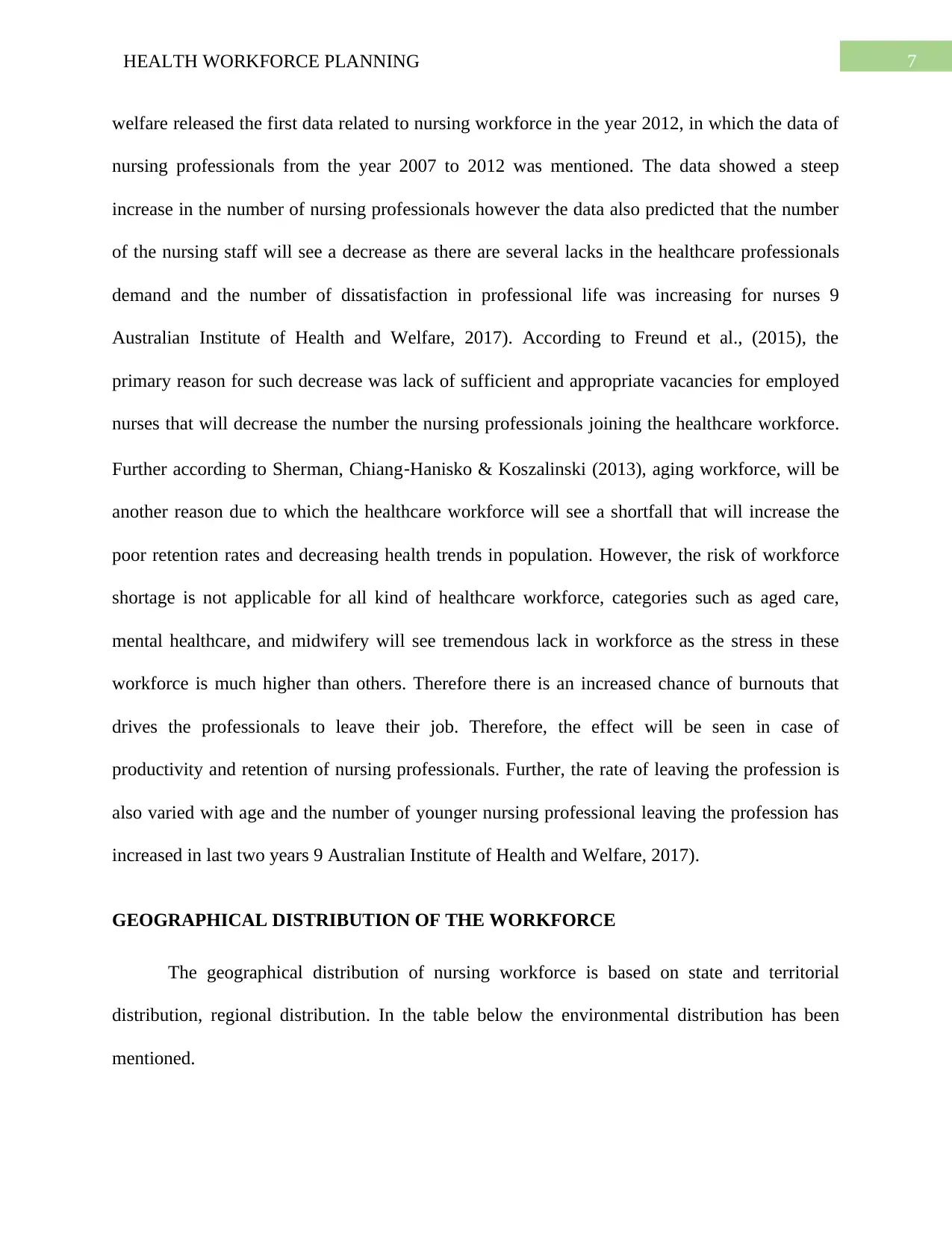
7HEALTH WORKFORCE PLANNING
welfare released the first data related to nursing workforce in the year 2012, in which the data of
nursing professionals from the year 2007 to 2012 was mentioned. The data showed a steep
increase in the number of nursing professionals however the data also predicted that the number
of the nursing staff will see a decrease as there are several lacks in the healthcare professionals
demand and the number of dissatisfaction in professional life was increasing for nurses 9
Australian Institute of Health and Welfare, 2017). According to Freund et al., (2015), the
primary reason for such decrease was lack of sufficient and appropriate vacancies for employed
nurses that will decrease the number the nursing professionals joining the healthcare workforce.
Further according to Sherman, Chiang‐Hanisko & Koszalinski (2013), aging workforce, will be
another reason due to which the healthcare workforce will see a shortfall that will increase the
poor retention rates and decreasing health trends in population. However, the risk of workforce
shortage is not applicable for all kind of healthcare workforce, categories such as aged care,
mental healthcare, and midwifery will see tremendous lack in workforce as the stress in these
workforce is much higher than others. Therefore there is an increased chance of burnouts that
drives the professionals to leave their job. Therefore, the effect will be seen in case of
productivity and retention of nursing professionals. Further, the rate of leaving the profession is
also varied with age and the number of younger nursing professional leaving the profession has
increased in last two years 9 Australian Institute of Health and Welfare, 2017).
GEOGRAPHICAL DISTRIBUTION OF THE WORKFORCE
The geographical distribution of nursing workforce is based on state and territorial
distribution, regional distribution. In the table below the environmental distribution has been
mentioned.
welfare released the first data related to nursing workforce in the year 2012, in which the data of
nursing professionals from the year 2007 to 2012 was mentioned. The data showed a steep
increase in the number of nursing professionals however the data also predicted that the number
of the nursing staff will see a decrease as there are several lacks in the healthcare professionals
demand and the number of dissatisfaction in professional life was increasing for nurses 9
Australian Institute of Health and Welfare, 2017). According to Freund et al., (2015), the
primary reason for such decrease was lack of sufficient and appropriate vacancies for employed
nurses that will decrease the number the nursing professionals joining the healthcare workforce.
Further according to Sherman, Chiang‐Hanisko & Koszalinski (2013), aging workforce, will be
another reason due to which the healthcare workforce will see a shortfall that will increase the
poor retention rates and decreasing health trends in population. However, the risk of workforce
shortage is not applicable for all kind of healthcare workforce, categories such as aged care,
mental healthcare, and midwifery will see tremendous lack in workforce as the stress in these
workforce is much higher than others. Therefore there is an increased chance of burnouts that
drives the professionals to leave their job. Therefore, the effect will be seen in case of
productivity and retention of nursing professionals. Further, the rate of leaving the profession is
also varied with age and the number of younger nursing professional leaving the profession has
increased in last two years 9 Australian Institute of Health and Welfare, 2017).
GEOGRAPHICAL DISTRIBUTION OF THE WORKFORCE
The geographical distribution of nursing workforce is based on state and territorial
distribution, regional distribution. In the table below the environmental distribution has been
mentioned.
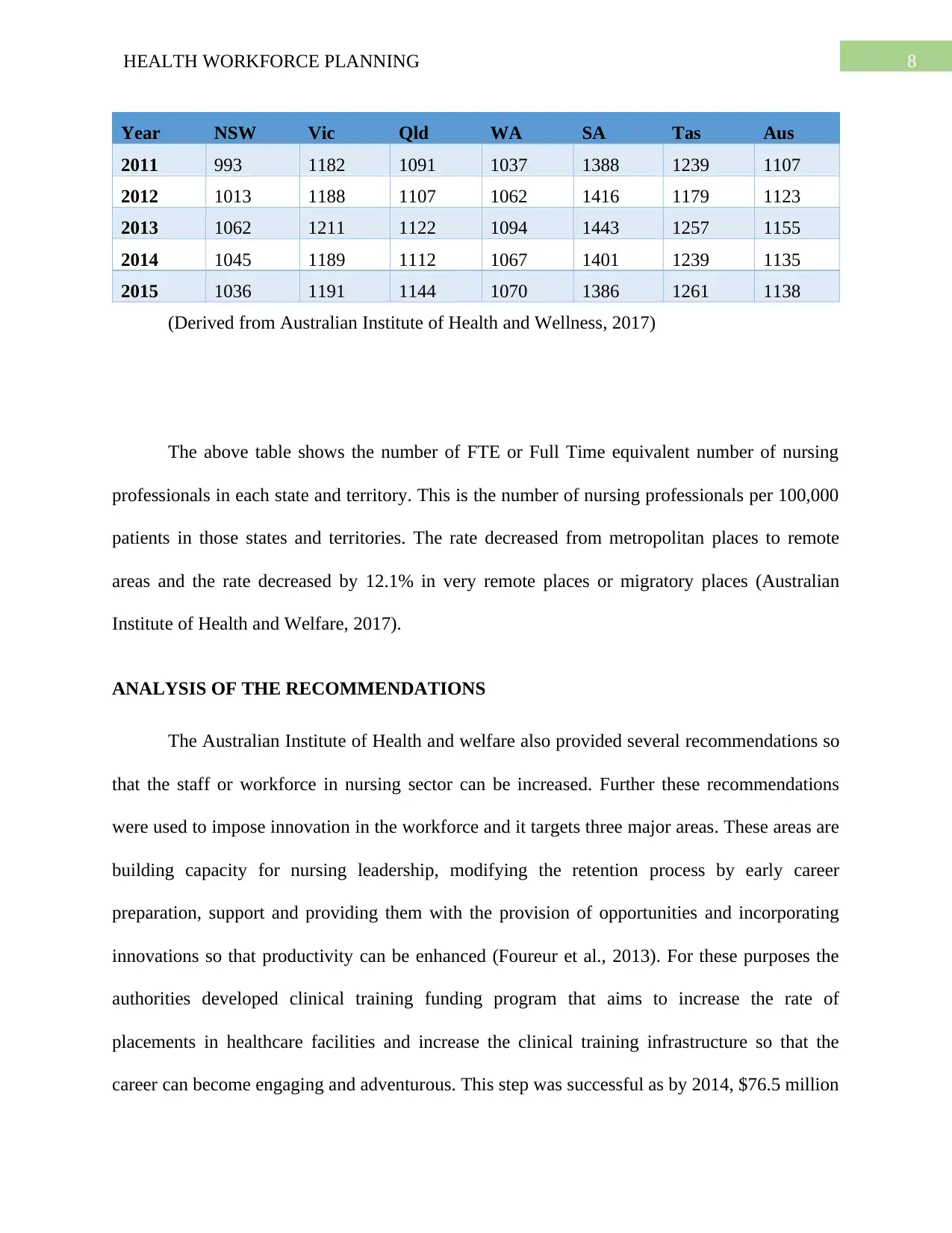
8HEALTH WORKFORCE PLANNING
Year NSW Vic Qld WA SA Tas Aus
2011 993 1182 1091 1037 1388 1239 1107
2012 1013 1188 1107 1062 1416 1179 1123
2013 1062 1211 1122 1094 1443 1257 1155
2014 1045 1189 1112 1067 1401 1239 1135
2015 1036 1191 1144 1070 1386 1261 1138
(Derived from Australian Institute of Health and Wellness, 2017)
The above table shows the number of FTE or Full Time equivalent number of nursing
professionals in each state and territory. This is the number of nursing professionals per 100,000
patients in those states and territories. The rate decreased from metropolitan places to remote
areas and the rate decreased by 12.1% in very remote places or migratory places (Australian
Institute of Health and Welfare, 2017).
ANALYSIS OF THE RECOMMENDATIONS
The Australian Institute of Health and welfare also provided several recommendations so
that the staff or workforce in nursing sector can be increased. Further these recommendations
were used to impose innovation in the workforce and it targets three major areas. These areas are
building capacity for nursing leadership, modifying the retention process by early career
preparation, support and providing them with the provision of opportunities and incorporating
innovations so that productivity can be enhanced (Foureur et al., 2013). For these purposes the
authorities developed clinical training funding program that aims to increase the rate of
placements in healthcare facilities and increase the clinical training infrastructure so that the
career can become engaging and adventurous. This step was successful as by 2014, $76.5 million
Year NSW Vic Qld WA SA Tas Aus
2011 993 1182 1091 1037 1388 1239 1107
2012 1013 1188 1107 1062 1416 1179 1123
2013 1062 1211 1122 1094 1443 1257 1155
2014 1045 1189 1112 1067 1401 1239 1135
2015 1036 1191 1144 1070 1386 1261 1138
(Derived from Australian Institute of Health and Wellness, 2017)
The above table shows the number of FTE or Full Time equivalent number of nursing
professionals in each state and territory. This is the number of nursing professionals per 100,000
patients in those states and territories. The rate decreased from metropolitan places to remote
areas and the rate decreased by 12.1% in very remote places or migratory places (Australian
Institute of Health and Welfare, 2017).
ANALYSIS OF THE RECOMMENDATIONS
The Australian Institute of Health and welfare also provided several recommendations so
that the staff or workforce in nursing sector can be increased. Further these recommendations
were used to impose innovation in the workforce and it targets three major areas. These areas are
building capacity for nursing leadership, modifying the retention process by early career
preparation, support and providing them with the provision of opportunities and incorporating
innovations so that productivity can be enhanced (Foureur et al., 2013). For these purposes the
authorities developed clinical training funding program that aims to increase the rate of
placements in healthcare facilities and increase the clinical training infrastructure so that the
career can become engaging and adventurous. This step was successful as by 2014, $76.5 million
⊘ This is a preview!⊘
Do you want full access?
Subscribe today to unlock all pages.

Trusted by 1+ million students worldwide
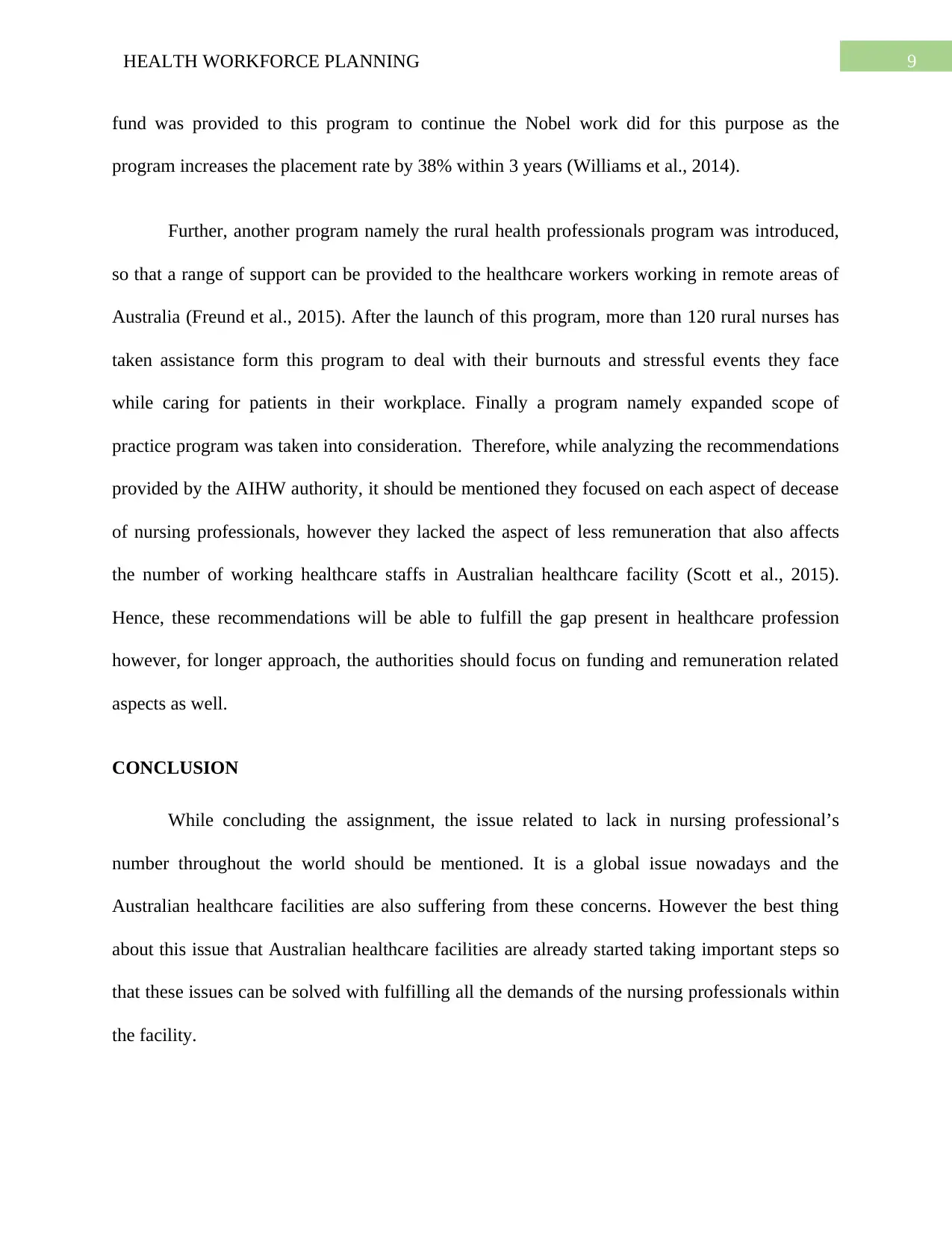
9HEALTH WORKFORCE PLANNING
fund was provided to this program to continue the Nobel work did for this purpose as the
program increases the placement rate by 38% within 3 years (Williams et al., 2014).
Further, another program namely the rural health professionals program was introduced,
so that a range of support can be provided to the healthcare workers working in remote areas of
Australia (Freund et al., 2015). After the launch of this program, more than 120 rural nurses has
taken assistance form this program to deal with their burnouts and stressful events they face
while caring for patients in their workplace. Finally a program namely expanded scope of
practice program was taken into consideration. Therefore, while analyzing the recommendations
provided by the AIHW authority, it should be mentioned they focused on each aspect of decease
of nursing professionals, however they lacked the aspect of less remuneration that also affects
the number of working healthcare staffs in Australian healthcare facility (Scott et al., 2015).
Hence, these recommendations will be able to fulfill the gap present in healthcare profession
however, for longer approach, the authorities should focus on funding and remuneration related
aspects as well.
CONCLUSION
While concluding the assignment, the issue related to lack in nursing professional’s
number throughout the world should be mentioned. It is a global issue nowadays and the
Australian healthcare facilities are also suffering from these concerns. However the best thing
about this issue that Australian healthcare facilities are already started taking important steps so
that these issues can be solved with fulfilling all the demands of the nursing professionals within
the facility.
fund was provided to this program to continue the Nobel work did for this purpose as the
program increases the placement rate by 38% within 3 years (Williams et al., 2014).
Further, another program namely the rural health professionals program was introduced,
so that a range of support can be provided to the healthcare workers working in remote areas of
Australia (Freund et al., 2015). After the launch of this program, more than 120 rural nurses has
taken assistance form this program to deal with their burnouts and stressful events they face
while caring for patients in their workplace. Finally a program namely expanded scope of
practice program was taken into consideration. Therefore, while analyzing the recommendations
provided by the AIHW authority, it should be mentioned they focused on each aspect of decease
of nursing professionals, however they lacked the aspect of less remuneration that also affects
the number of working healthcare staffs in Australian healthcare facility (Scott et al., 2015).
Hence, these recommendations will be able to fulfill the gap present in healthcare profession
however, for longer approach, the authorities should focus on funding and remuneration related
aspects as well.
CONCLUSION
While concluding the assignment, the issue related to lack in nursing professional’s
number throughout the world should be mentioned. It is a global issue nowadays and the
Australian healthcare facilities are also suffering from these concerns. However the best thing
about this issue that Australian healthcare facilities are already started taking important steps so
that these issues can be solved with fulfilling all the demands of the nursing professionals within
the facility.
Paraphrase This Document
Need a fresh take? Get an instant paraphrase of this document with our AI Paraphraser
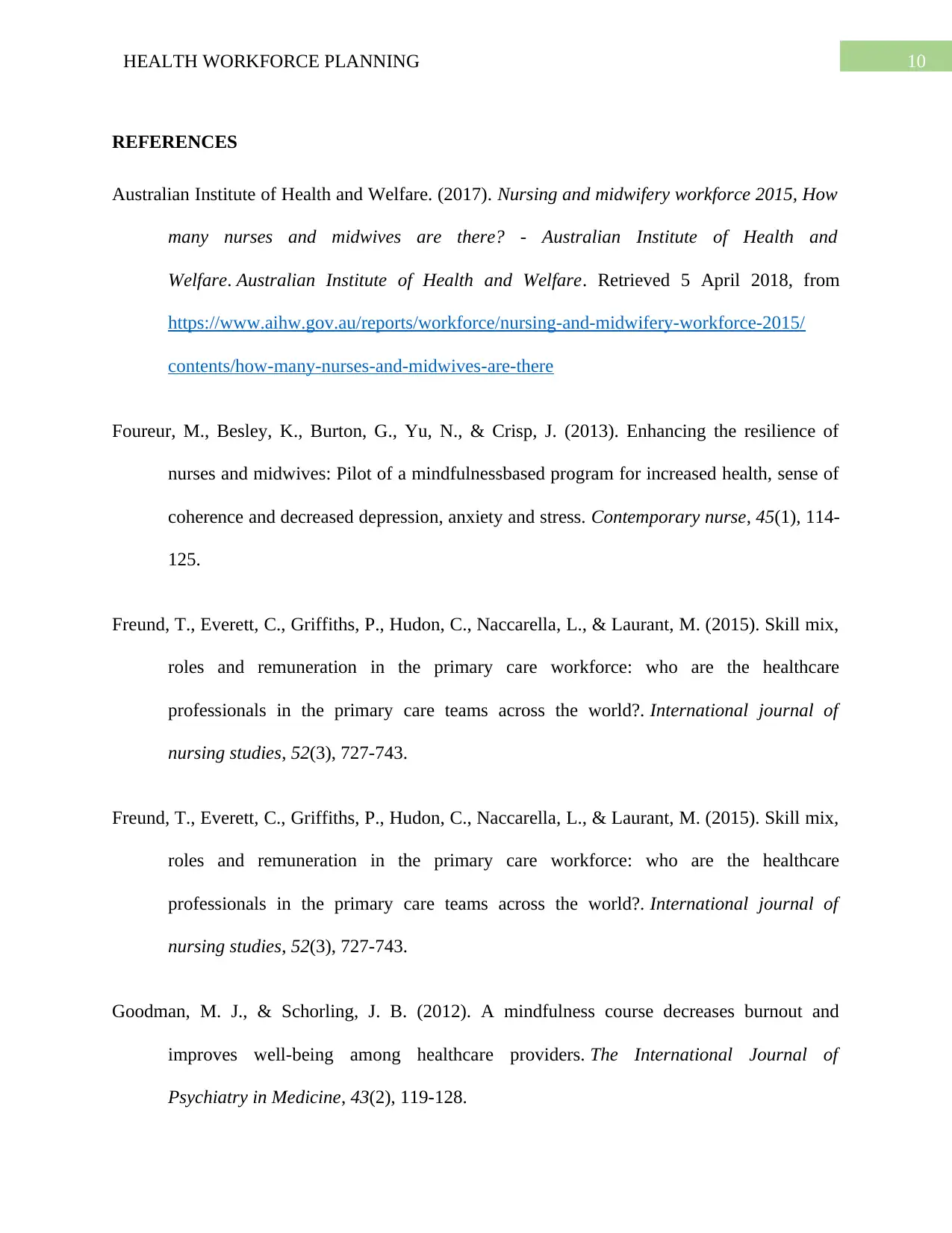
10HEALTH WORKFORCE PLANNING
REFERENCES
Australian Institute of Health and Welfare. (2017). Nursing and midwifery workforce 2015, How
many nurses and midwives are there? - Australian Institute of Health and
Welfare. Australian Institute of Health and Welfare. Retrieved 5 April 2018, from
https://www.aihw.gov.au/reports/workforce/nursing-and-midwifery-workforce-2015/
contents/how-many-nurses-and-midwives-are-there
Foureur, M., Besley, K., Burton, G., Yu, N., & Crisp, J. (2013). Enhancing the resilience of
nurses and midwives: Pilot of a mindfulnessbased program for increased health, sense of
coherence and decreased depression, anxiety and stress. Contemporary nurse, 45(1), 114-
125.
Freund, T., Everett, C., Griffiths, P., Hudon, C., Naccarella, L., & Laurant, M. (2015). Skill mix,
roles and remuneration in the primary care workforce: who are the healthcare
professionals in the primary care teams across the world?. International journal of
nursing studies, 52(3), 727-743.
Freund, T., Everett, C., Griffiths, P., Hudon, C., Naccarella, L., & Laurant, M. (2015). Skill mix,
roles and remuneration in the primary care workforce: who are the healthcare
professionals in the primary care teams across the world?. International journal of
nursing studies, 52(3), 727-743.
Goodman, M. J., & Schorling, J. B. (2012). A mindfulness course decreases burnout and
improves well-being among healthcare providers. The International Journal of
Psychiatry in Medicine, 43(2), 119-128.
REFERENCES
Australian Institute of Health and Welfare. (2017). Nursing and midwifery workforce 2015, How
many nurses and midwives are there? - Australian Institute of Health and
Welfare. Australian Institute of Health and Welfare. Retrieved 5 April 2018, from
https://www.aihw.gov.au/reports/workforce/nursing-and-midwifery-workforce-2015/
contents/how-many-nurses-and-midwives-are-there
Foureur, M., Besley, K., Burton, G., Yu, N., & Crisp, J. (2013). Enhancing the resilience of
nurses and midwives: Pilot of a mindfulnessbased program for increased health, sense of
coherence and decreased depression, anxiety and stress. Contemporary nurse, 45(1), 114-
125.
Freund, T., Everett, C., Griffiths, P., Hudon, C., Naccarella, L., & Laurant, M. (2015). Skill mix,
roles and remuneration in the primary care workforce: who are the healthcare
professionals in the primary care teams across the world?. International journal of
nursing studies, 52(3), 727-743.
Freund, T., Everett, C., Griffiths, P., Hudon, C., Naccarella, L., & Laurant, M. (2015). Skill mix,
roles and remuneration in the primary care workforce: who are the healthcare
professionals in the primary care teams across the world?. International journal of
nursing studies, 52(3), 727-743.
Goodman, M. J., & Schorling, J. B. (2012). A mindfulness course decreases burnout and
improves well-being among healthcare providers. The International Journal of
Psychiatry in Medicine, 43(2), 119-128.
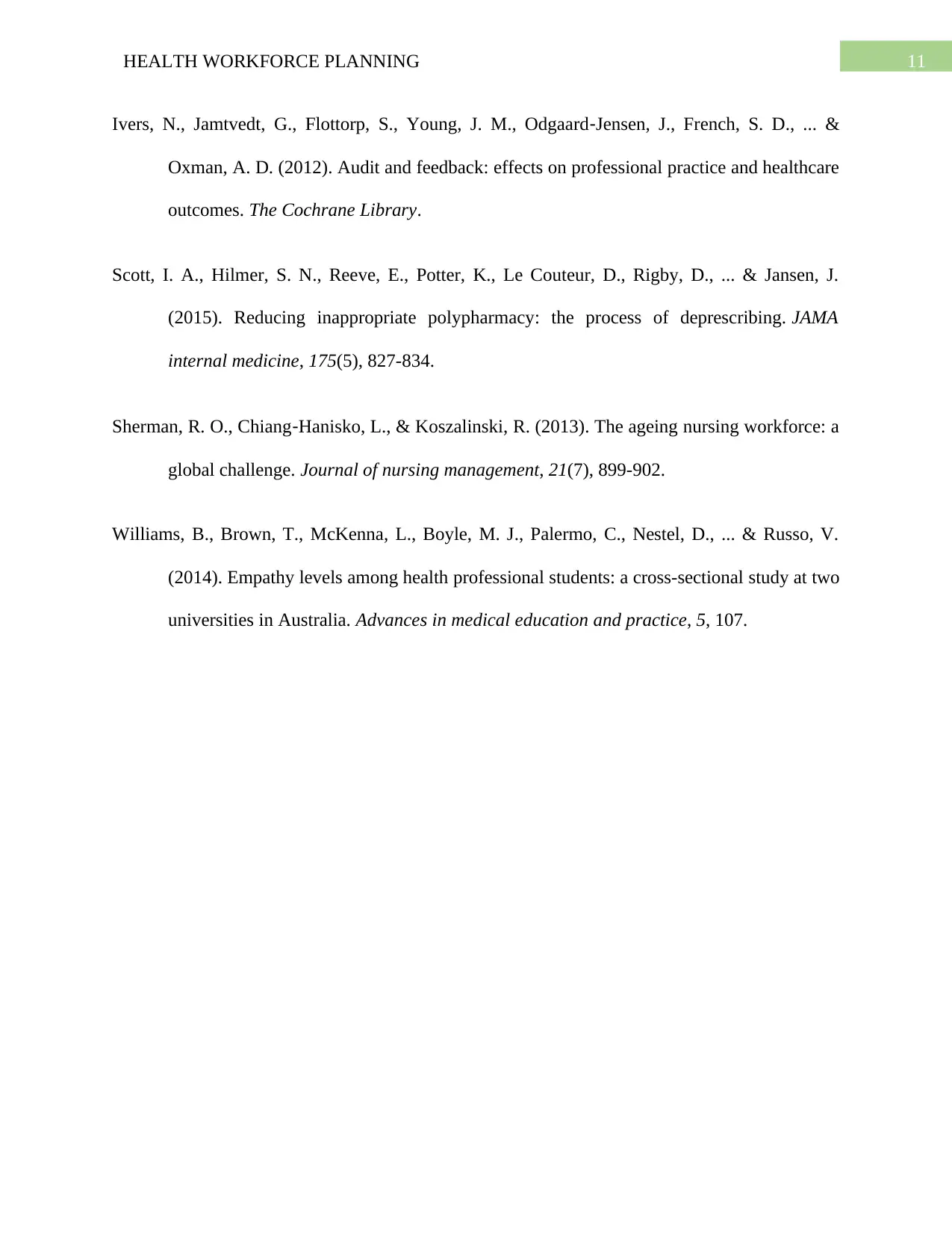
11HEALTH WORKFORCE PLANNING
Ivers, N., Jamtvedt, G., Flottorp, S., Young, J. M., Odgaard‐Jensen, J., French, S. D., ... &
Oxman, A. D. (2012). Audit and feedback: effects on professional practice and healthcare
outcomes. The Cochrane Library.
Scott, I. A., Hilmer, S. N., Reeve, E., Potter, K., Le Couteur, D., Rigby, D., ... & Jansen, J.
(2015). Reducing inappropriate polypharmacy: the process of deprescribing. JAMA
internal medicine, 175(5), 827-834.
Sherman, R. O., Chiang‐Hanisko, L., & Koszalinski, R. (2013). The ageing nursing workforce: a
global challenge. Journal of nursing management, 21(7), 899-902.
Williams, B., Brown, T., McKenna, L., Boyle, M. J., Palermo, C., Nestel, D., ... & Russo, V.
(2014). Empathy levels among health professional students: a cross-sectional study at two
universities in Australia. Advances in medical education and practice, 5, 107.
Ivers, N., Jamtvedt, G., Flottorp, S., Young, J. M., Odgaard‐Jensen, J., French, S. D., ... &
Oxman, A. D. (2012). Audit and feedback: effects on professional practice and healthcare
outcomes. The Cochrane Library.
Scott, I. A., Hilmer, S. N., Reeve, E., Potter, K., Le Couteur, D., Rigby, D., ... & Jansen, J.
(2015). Reducing inappropriate polypharmacy: the process of deprescribing. JAMA
internal medicine, 175(5), 827-834.
Sherman, R. O., Chiang‐Hanisko, L., & Koszalinski, R. (2013). The ageing nursing workforce: a
global challenge. Journal of nursing management, 21(7), 899-902.
Williams, B., Brown, T., McKenna, L., Boyle, M. J., Palermo, C., Nestel, D., ... & Russo, V.
(2014). Empathy levels among health professional students: a cross-sectional study at two
universities in Australia. Advances in medical education and practice, 5, 107.
⊘ This is a preview!⊘
Do you want full access?
Subscribe today to unlock all pages.

Trusted by 1+ million students worldwide
1 out of 12
Related Documents
Your All-in-One AI-Powered Toolkit for Academic Success.
+13062052269
info@desklib.com
Available 24*7 on WhatsApp / Email
![[object Object]](/_next/static/media/star-bottom.7253800d.svg)
Unlock your academic potential
Copyright © 2020–2025 A2Z Services. All Rights Reserved. Developed and managed by ZUCOL.





